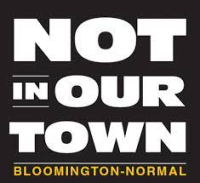Segregation
Segregation returns to downtown Bloomington
The Illinois House
211 W. Jefferson St., Bloomington
Location notes: The Illinois House building still stands today, at the corner of Center and Jefferson streets. The Ashley House was on this site until it burned down in the Great Fire of June 19-20, 1900.
After the U.S. Civil War (1861-1865) African Americans enjoyed free movement in the community. They shopped various stores and found employment and accommodation in hotels and restaurants. A premier Bloomington hotel at 211 W. Jefferson Street was the Ashley House. The hotel did not segregate – famed abolitionist Frederick Douglass stayed there on January 9, 1873 when lecturing at Schroeder’s Opera House. When the famed Fisk Jubilee Singers came to town to perform, these African American college students stayed at the Ashley House.
However, by the early 20th century, these patterns changed. Segregation became common community practice. In downtown department stores and shops, African Americans could buy clothing, but could not try it on. Restaurants only served African American patrons at the back door with carry-out food. The 1900 Great Bloomington Fire destroyed the Ashley House (which had been renamed the Windsor Hotel). The Illinois House was built on the site and opened in 1902 with 180 rooms and full service luxuries, including a barbershop, tailor, pharmacy, and millinery. African Americans were not allowed to stay there.
This transition was common in U.S. northern society. As the Civil War generation passed on, segregation returned. This played out at the national level with the Woodrow Wilson presidency (1912-1920). Wilson came from a family supporting human enslavement and the Confederate rebellion. When the film The Birth of a Nation, based on the novel The Clansman, came out in 1915, Wilson praised the film and had it shown in the White House. This national political shift sanctioned racial segregation in communities where it was not necessarily law but became a custom. The 1920s saw the Ku Klux Klan revived – this time the Klan was not only anti-African American, but also anti-Catholic, anti-Jewish, and anti-immigrant.




Additional information can be found at the following links:
WGLT McHistory — Segregation in Bloomington-Normal
YouTube (audio only) — Segregation: Our Community’s Secret. A presentation by Mark Wyman
Ku Klux Klan 1921 – A Community in Conflict – McLean County Museum of History online exhibit
The American Presidency Project — Woodrow Wilson
The Influence of “The Birth of a Nation” from Facing History & Ourselves
Great Bloomington Fire of 1900 – McLean County Museum of History
Pages from our Past — Bloomington’s Ashley House had eventful life before burning down




